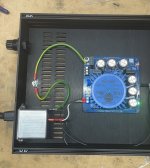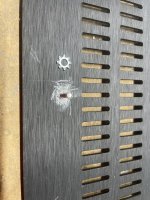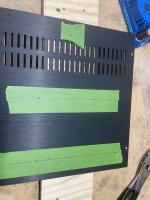@6L6
I get that. One can bring anything one wants to the party.
But someone unfamiliar with Pearl 2 mightn't know about the bridge or why it was strongly advocated for.
And while it's natural for Wayne to focus only on the new and the improved aspects, comes time to build -- or discuss building -- it would be helpful not to discard prior progress. No?
Just sayin'
I get that. One can bring anything one wants to the party.
But someone unfamiliar with Pearl 2 mightn't know about the bridge or why it was strongly advocated for.
And while it's natural for Wayne to focus only on the new and the improved aspects, comes time to build -- or discuss building -- it would be helpful not to discard prior progress. No?
Just sayin'
Does this opamp:
https://www.analog.com/media/en/technical-documentation/data-sheets/lt1115fa.pdf
exist in a dual-version that has same low noise figures (around 1 nV/Hz-2 at 1 kHz?).
I can find one called LT1126 but it is quite noisy (compared to LT1115).
Would it be an option to use a 2 x single to dual converter socket?
https://www.analog.com/media/en/technical-documentation/data-sheets/lt1115fa.pdf
exist in a dual-version that has same low noise figures (around 1 nV/Hz-2 at 1 kHz?).
I can find one called LT1126 but it is quite noisy (compared to LT1115).
Would it be an option to use a 2 x single to dual converter socket?
Hello All,
The power supply is important.
Just for the fun of it I wanted to see what the capacitance multiplier was all about. On a bread board I built the capacitance multiplier part of the circuit, rather than including the Jfets there is a resistor in their place.
Looking at the project PCB’s they are much smaller than the Pearl 2 boards. There is a much smaller foot print for filtering capacitors. The pearl 2 has much more capacitance on the project boards.
My little bread board only has the capacitance multiplier part of the circuit. The 7815 linear voltage regulator was not included. I tried put two different 15VDC power supplies and connected things up to the APx555 analyzer on the bench; Keysight E36312A and a switching wall wart type supply that we often see. Using the Triad switching supply both the FFT and O’Scope screens were a mess. Using the Keysight supply the AC ripple was still prominent but reduced by 23dB compared to the Triad wall wart supply.
Increasing the on board capacitance helps a fair amount.
My guess is that the capacitance multiplier part of the circuit is intended as a final polish for the external PS and on board 7815 regulator. Also looks to me like that the on board capacitance multiplier was called on to do more in the Pearl 2.
Coming up:
A 7815 regulator on an additional breadboard.
Measurement of the bread board PSRR. (Oops, unfortunately the Picotest voltage injector got left in the storage container, it will be back soon.)
I did note that even with the power supply disconnected there was AC "ripple" leaking in. I will also add and include a cookie tin or two for the measurements.
My wife and I will be snowbirds for the rest of the month; we are headed to the SoCal Desert to visit #1 son.
Thanks DT
Inspired by @jackinnj
The power supply is important.
Just for the fun of it I wanted to see what the capacitance multiplier was all about. On a bread board I built the capacitance multiplier part of the circuit, rather than including the Jfets there is a resistor in their place.
Looking at the project PCB’s they are much smaller than the Pearl 2 boards. There is a much smaller foot print for filtering capacitors. The pearl 2 has much more capacitance on the project boards.
My little bread board only has the capacitance multiplier part of the circuit. The 7815 linear voltage regulator was not included. I tried put two different 15VDC power supplies and connected things up to the APx555 analyzer on the bench; Keysight E36312A and a switching wall wart type supply that we often see. Using the Triad switching supply both the FFT and O’Scope screens were a mess. Using the Keysight supply the AC ripple was still prominent but reduced by 23dB compared to the Triad wall wart supply.
Increasing the on board capacitance helps a fair amount.
My guess is that the capacitance multiplier part of the circuit is intended as a final polish for the external PS and on board 7815 regulator. Also looks to me like that the on board capacitance multiplier was called on to do more in the Pearl 2.
Coming up:
A 7815 regulator on an additional breadboard.
Measurement of the bread board PSRR. (Oops, unfortunately the Picotest voltage injector got left in the storage container, it will be back soon.)
I did note that even with the power supply disconnected there was AC "ripple" leaking in. I will also add and include a cookie tin or two for the measurements.
My wife and I will be snowbirds for the rest of the month; we are headed to the SoCal Desert to visit #1 son.
Thanks DT
Inspired by @jackinnj
A converter like this.....I was thinking about (one smd pr side so it does not take up much space):
https://www.soundlabsgroup.com.au/p/BD-020302S/Single+to+Dual+Op-Amp+SMD+With+Pins
Then I already have opamps like OPA1611a which looks like a low noise type.
I also have ADA 4898-1 which is also a low noise type (and unity gain stable pr. data sheet).
https://www.soundlabsgroup.com.au/p/BD-020302S/Single+to+Dual+Op-Amp+SMD+With+Pins
Then I already have opamps like OPA1611a which looks like a low noise type.
I also have ADA 4898-1 which is also a low noise type (and unity gain stable pr. data sheet).
Thank you.
I looked what I have and I have those small smd to dip8 converter PCB's.
But I may just solder the smd opamp directly to PCB (from memory it has smd footprint also?).
If not I will use the smd to dip8 converter PCB.
I also did order some of the 2 x single opamp to dip8 converter PCB's so I have both options.
But for ADA4898-1 vs. ADA4898-2 there seems not to be any advantages using two singles (other than I already have the singles).
I looked what I have and I have those small smd to dip8 converter PCB's.
But I may just solder the smd opamp directly to PCB (from memory it has smd footprint also?).
If not I will use the smd to dip8 converter PCB.
I also did order some of the 2 x single opamp to dip8 converter PCB's so I have both options.
But for ADA4898-1 vs. ADA4898-2 there seems not to be any advantages using two singles (other than I already have the singles).
Thank you!
I ordered some ADA4898-2 and made my final decision to use those for P3 and solder them in.....and don't look back!
I ordered some ADA4898-2 and made my final decision to use those for P3 and solder them in.....and don't look back!
Power supply box is assembled and working.
Tomorrow I plan to prepare the umbilical cable and then the main box.
I did a little drill work on the bottom plate. We may go for pre drilled on the production boxes. You can see a little scraping and a star washer to ensure a good connection for the chassis / earth ground point.
IEC is a filtered and fused unit from Schurter.
Tomorrow I plan to prepare the umbilical cable and then the main box.
I did a little drill work on the bottom plate. We may go for pre drilled on the production boxes. You can see a little scraping and a star washer to ensure a good connection for the chassis / earth ground point.
IEC is a filtered and fused unit from Schurter.
Attachments
I know, and I was thinking about that. But my ODC tells me that I should go for the most quiet opamp I can find (that works in the circuit) and then a soldered connection in such a sensitive circuit will give the best performance 🙂@MEPER
Install the socket and look forward to trying various opamps. It’s part of the magic of Pearl 3.
🙂
The problem with even the best of the "tulipan" 8-dip sockets is that it "bites" only very well first time you insert an opamp. Next time it is a bit more "sloppy" or easy to put in. That makes we want to only use a socket once 🙂 .....the Whammy was a big dilemma regarding this.....
It will be difficult to find a more silent dual opamp?
https://www.analog.com/media/en/technical-documentation/data-sheets/ADA4898-1_4898-2.pdf
It works with +-15 VDC supply, is unity gain stable, not "superfast" so we don't expect problems with oscillation?
Active filter is mentioned as application.
If my calculation is correct regarding 5 mV output MM-cartridge 49 dB setting will give 1.4 V out. That is ok I guess.
My plan is to use Whammy (appprox. 6dB I lowered the gain) and then IronPre (12 dB) to source follower amp Lazy Singing Bush.
IronPre has no pot. That is why I will put Whammy in the chain. Also with 1.4V out max. and 12 dB for a source follower may just be not enough (with 94 dB speakers).
https://www.analog.com/media/en/technical-documentation/data-sheets/ADA4898-1_4898-2.pdf
It works with +-15 VDC supply, is unity gain stable, not "superfast" so we don't expect problems with oscillation?
Active filter is mentioned as application.
If my calculation is correct regarding 5 mV output MM-cartridge 49 dB setting will give 1.4 V out. That is ok I guess.
My plan is to use Whammy (appprox. 6dB I lowered the gain) and then IronPre (12 dB) to source follower amp Lazy Singing Bush.
IronPre has no pot. That is why I will put Whammy in the chain. Also with 1.4V out max. and 12 dB for a source follower may just be not enough (with 94 dB speakers).
For a listening evaluation of the ADA4898 opamp, see M2x post #4603 {notice that it is blind listening} ... and the blindfold comes off at M2x post #4755.
But as George Carlin said about the 1978 Supreme Court's decision, ruling that his comedy was obscene: Hey, that's their opinion . Other people may have different opinions.
But as George Carlin said about the 1978 Supreme Court's decision, ruling that his comedy was obscene: Hey, that's their opinion . Other people may have different opinions.
Which opamp would be better in the Pearl 3 if one is aiming for lowest noise (hiss at the speaker): the OPA1612 with low voltage noise and higher current noise vs the OPA1656 with higher voltage noise but lower current noise?
Interesting (2-dimentional)!For a listening evaluation of the ADA4898 opamp, see M2x post #4603 {notice that it is blind listening} ... and the blindfold comes off at M2x post #4755.
But as George Carlin said about the 1978 Supreme Court's decision, ruling that his comedy was obscene: Hey, that's their opinion . Other people may have different opinions.
https://www.diyaudio.com/community/threads/the-diyaudio-first-watt-m2x.321925/page-238
What could be interesting also is that the "random test" was repeated several times to see if the description of the opamps was exactly the same (or close)?
I trust the 4898 will do its job well. I prefer a very silent setup so I must admit I selected the 4898 based on data sheet and the brand (Analog Devices) 🙂
I am sure a very clever person has designed the 4898.
- Home
- Amplifiers
- Pass Labs
- Pearl 3 Burning Amp 2023



